Introduction to Management | Makro
Added on 2022-02-04
40 Pages9903 Words49 Views
Assignment front sheet
Learner name Assessor name
XXXXXXXX XXXXX
Date issued Completion date Submitted on
XXXXX XXXXX XXXXX
Qualification Unit number and title
Edexcel BTEC Level 5 HND Diploma in
Business Term 1 Introduction to Management
Assignment
title Foundation studies
In this assessment, you will have opportunities to provide evidence against the following criteria.
Indicate the page numbers where the evidence can be found.
Criteria
referenc
e
To achieve the criteria the evidence must show that
the student is able to:
Task
no. Evidence
P1
Explain appropriate description of management role in today’s
organization with SWOT and PETLE analysis, produce vision,
mission and objectives, organizational structure and suitable
leadership style and controlling method for a selected
organization.
1 and
2 16-32
P2
Explain the various elements of marketing process and develop
market segmentation criteria, targeting strategy, positioning
method and marketing mix for a selected organization.
2 25-28
P3
Apply Harvard Style Referencing style with acceptable
presentation format which is suitable for the leaders 3 35-38
Learner declaration
I certify that the work submitted for this assignment is my own and research sources are fully acknowledged.
Learner signature: XXXXXX
Date: XXXXX
0
Learner name Assessor name
XXXXXXXX XXXXX
Date issued Completion date Submitted on
XXXXX XXXXX XXXXX
Qualification Unit number and title
Edexcel BTEC Level 5 HND Diploma in
Business Term 1 Introduction to Management
Assignment
title Foundation studies
In this assessment, you will have opportunities to provide evidence against the following criteria.
Indicate the page numbers where the evidence can be found.
Criteria
referenc
e
To achieve the criteria the evidence must show that
the student is able to:
Task
no. Evidence
P1
Explain appropriate description of management role in today’s
organization with SWOT and PETLE analysis, produce vision,
mission and objectives, organizational structure and suitable
leadership style and controlling method for a selected
organization.
1 and
2 16-32
P2
Explain the various elements of marketing process and develop
market segmentation criteria, targeting strategy, positioning
method and marketing mix for a selected organization.
2 25-28
P3
Apply Harvard Style Referencing style with acceptable
presentation format which is suitable for the leaders 3 35-38
Learner declaration
I certify that the work submitted for this assignment is my own and research sources are fully acknowledged.
Learner signature: XXXXXX
Date: XXXXX
0

Theoretical Report on Management and Leadership Fundamentals and Business Plan of
Makro for 2021
Prepared by the business development team
Submitted to Marketing Director
Date of submission: 15th Oct 2020
Executive Summary
1
Makro for 2021
Prepared by the business development team
Submitted to Marketing Director
Date of submission: 15th Oct 2020
Executive Summary
1
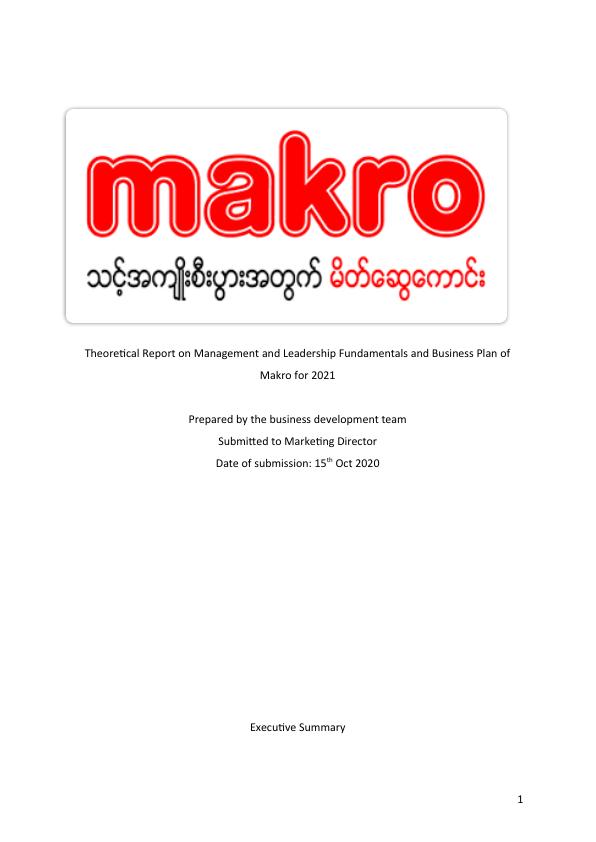
Makro is the new Thailand-based wholesale and retail outlet store in Yangon. The purpose
of this report is to explain the fundamentals of management and leadership. Moreover, the
report includes the business plan of Makro for 2021 and explanation of how this
organization proceed to build a better business in the future. The report is divided into 2
parts. In the first part, the report will cover management and leadership fundamentals such
as management functions, managerial roles and skills, leadership skills, etc. According to our
study, the second part focus on the organization’s information and organizational analysis.
Table of Contents
1.0 Introduction............................................................................................................4
2
of this report is to explain the fundamentals of management and leadership. Moreover, the
report includes the business plan of Makro for 2021 and explanation of how this
organization proceed to build a better business in the future. The report is divided into 2
parts. In the first part, the report will cover management and leadership fundamentals such
as management functions, managerial roles and skills, leadership skills, etc. According to our
study, the second part focus on the organization’s information and organizational analysis.
Table of Contents
1.0 Introduction............................................................................................................4
2
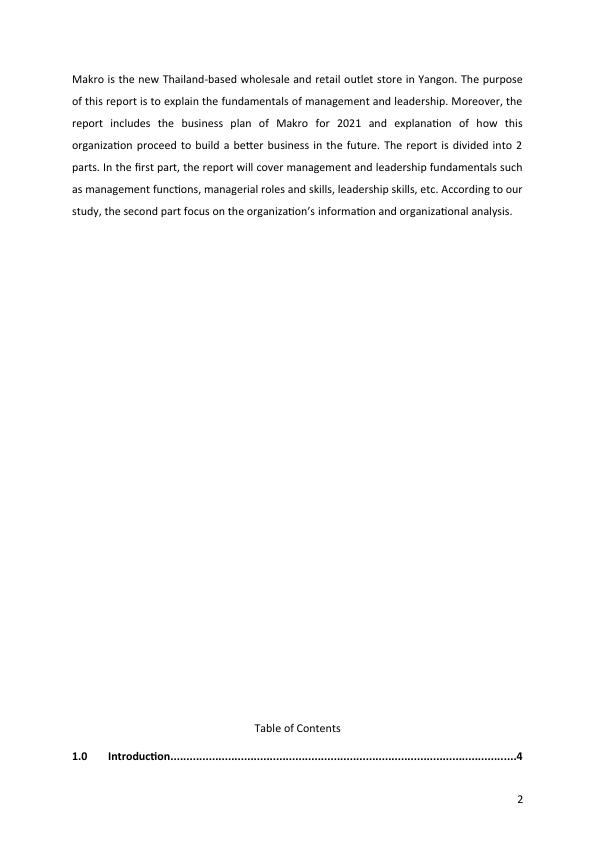
2.0 Management and Leadership Fundamentals................................................................4
2.1 Management................................................................................................................4
2.2 Leadership Definition.................................................................................................11
3.0 Business Profile (Vision, Mission, Objectives).............................................................14
4.0 PESTEL analysis...........................................................................................................16
4.1 Political factors...........................................................................................................16
4.2 Economic factors........................................................................................................17
4.3 Social factors..............................................................................................................18
4.4 Technological factors..................................................................................................18
4.5 Legal factors...............................................................................................................19
4.6 Environmental factors................................................................................................20
5.0 SWOT Analysis............................................................................................................21
5.1 Strengths....................................................................................................................22
5.2 Weaknesses................................................................................................................22
5.3 Opportunities.............................................................................................................23
5.4 Threats.......................................................................................................................24
6.0 Marketing Strategies (STP)..........................................................................................25
6.1 Segmentation.............................................................................................................25
6.2 Targeting....................................................................................................................26
6.3 Positioning.................................................................................................................27
7.0 Marketing Mix............................................................................................................28
8.0 Organizational structure.............................................................................................30
9.0 Controlling..................................................................................................................31
9.1 Leadership..................................................................................................................32
9.2 Conclusion..................................................................................................................32
9.3 Recommendations......................................................................................................32
10.0 Reference List...........................................................................................................35
3
2.1 Management................................................................................................................4
2.2 Leadership Definition.................................................................................................11
3.0 Business Profile (Vision, Mission, Objectives).............................................................14
4.0 PESTEL analysis...........................................................................................................16
4.1 Political factors...........................................................................................................16
4.2 Economic factors........................................................................................................17
4.3 Social factors..............................................................................................................18
4.4 Technological factors..................................................................................................18
4.5 Legal factors...............................................................................................................19
4.6 Environmental factors................................................................................................20
5.0 SWOT Analysis............................................................................................................21
5.1 Strengths....................................................................................................................22
5.2 Weaknesses................................................................................................................22
5.3 Opportunities.............................................................................................................23
5.4 Threats.......................................................................................................................24
6.0 Marketing Strategies (STP)..........................................................................................25
6.1 Segmentation.............................................................................................................25
6.2 Targeting....................................................................................................................26
6.3 Positioning.................................................................................................................27
7.0 Marketing Mix............................................................................................................28
8.0 Organizational structure.............................................................................................30
9.0 Controlling..................................................................................................................31
9.1 Leadership..................................................................................................................32
9.2 Conclusion..................................................................................................................32
9.3 Recommendations......................................................................................................32
10.0 Reference List...........................................................................................................35
3
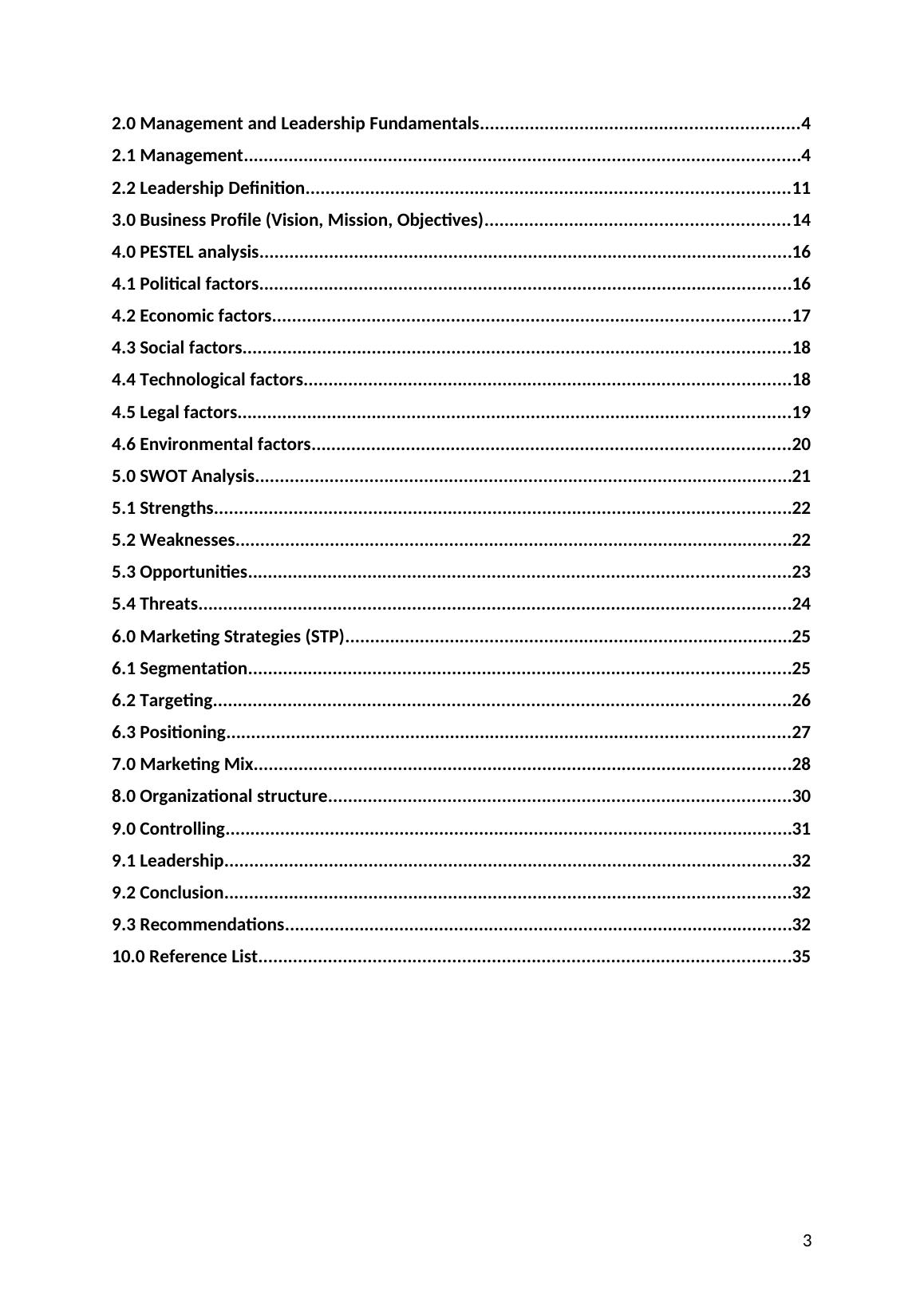
1.0 Introduction
This business report focus on how the Makro company processing with vision, missions and
how it attracting the customers with marketing strategies. The aim of this report is to
provide the understanding of management and leadership fundamentals which are used in
all organizations.
2.0 Management and Leadership Fundamentals
2.1 Management
Management can be defined as the process of administering and controlling the affairs of
the organization (Shraddha, 2019). The effective and efficient management will help to
improve the organization’s plans and goal tasks. Management is to succeed in the purposes
of the organizational goals by organizing and maintaining the accessible assets efficiently
and effectively (Robbins & Coulter, 2019). Poor management will drag down the
organization to the bottom where organization will face many challenges, risks and failures.
Types of Managers
In management, there are two types of Managers. The managers are Managerial Employees
and Non-managerial employees. Managerial Employees means that they have to control or
to make direct recommendations to other employees. Such as Marketing manager,
Production manager and Financial manager are control over their employees which are also
called non-managerial employees (Robbins & Coulter, 2019).
Non-managerial employees are that they have to do many things from top-level
management such as from managing director, general manager or managerial employees
(Robbins & Coulter, 2019). For example, in the finance department, the accountant and
cashier have to do what the Finance manager said.
4
This business report focus on how the Makro company processing with vision, missions and
how it attracting the customers with marketing strategies. The aim of this report is to
provide the understanding of management and leadership fundamentals which are used in
all organizations.
2.0 Management and Leadership Fundamentals
2.1 Management
Management can be defined as the process of administering and controlling the affairs of
the organization (Shraddha, 2019). The effective and efficient management will help to
improve the organization’s plans and goal tasks. Management is to succeed in the purposes
of the organizational goals by organizing and maintaining the accessible assets efficiently
and effectively (Robbins & Coulter, 2019). Poor management will drag down the
organization to the bottom where organization will face many challenges, risks and failures.
Types of Managers
In management, there are two types of Managers. The managers are Managerial Employees
and Non-managerial employees. Managerial Employees means that they have to control or
to make direct recommendations to other employees. Such as Marketing manager,
Production manager and Financial manager are control over their employees which are also
called non-managerial employees (Robbins & Coulter, 2019).
Non-managerial employees are that they have to do many things from top-level
management such as from managing director, general manager or managerial employees
(Robbins & Coulter, 2019). For example, in the finance department, the accountant and
cashier have to do what the Finance manager said.
4
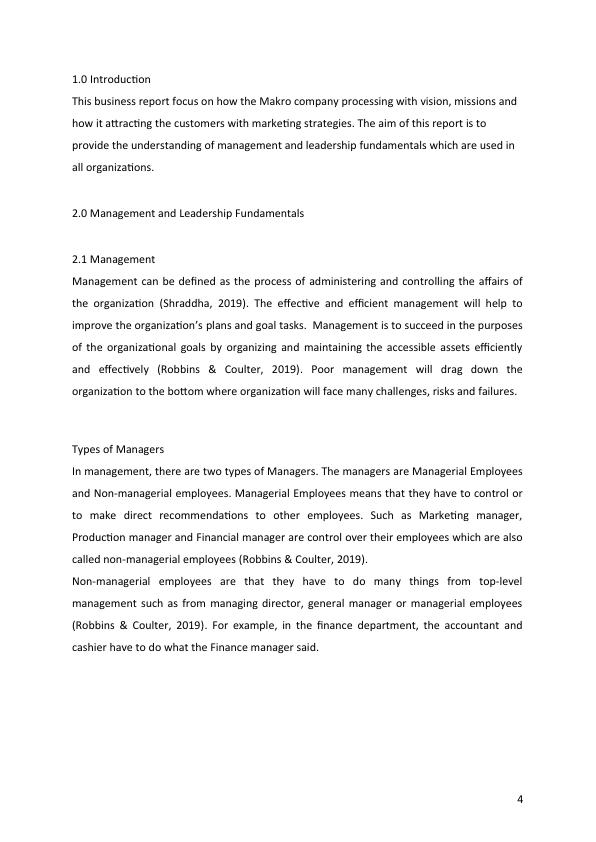
Vertical Classification of Managers
Top/Senior Managers
Top/Senior managers are who head the whole organization on the highest administrative
level. They officially manage the goals, policies and serious decision makings for an
organization (Kukreja, 2019). Since the top/senior managers organize many sectors and
departments which include the finance, technique and commerce, they are skillful in
controlling the movements of the firm at the same time (Kukreja, 2019). Senior managers
discuss with other top/senior Managers and make organization-wide decisions.
Examples: Board of Directors (BOD), Chief Executive Officer (CEO), Chief Financial Officer
(CFO), Chief Operating Officer (COO), President and the Vice President.
Middle Managers
The middle managers are who control the employment and regular training of the first-line
managers. As the middle managers are on the executive level being subordinates of the top
management, they communicate between the top and the lower level by transferring the
reports and data of the organization to the senior managers (Kukreja, 2019). Middle
managers organize activities of each department and perform the plans made by the senior
managers. They also motivate and lead the employees of the lower level.
Examples: Regional Managers, General Managers, Division Managers.
First-Line Managers
The first-line managers are who handle the operative members on the supervisory level.
They mostly use the working time by doing tasks for the organization that are usually passed
down from the managers from a higher level (Kukreja, 2019). The first-line managers feature
at the base however they are essential and manage the personnel which relates in solving
the fundamental problems and giving a firm basis to the higher levels (Kukreja, 2019). First-
line managers give management to the non-managerial employees on their daily jobs. They
report the periodic records of the employees to the higher-level managers. They also check
the quality and quantity of the production.
Examples: District Managers, Department Managers, Office Managers.
5
Top/Senior Managers
Top/Senior managers are who head the whole organization on the highest administrative
level. They officially manage the goals, policies and serious decision makings for an
organization (Kukreja, 2019). Since the top/senior managers organize many sectors and
departments which include the finance, technique and commerce, they are skillful in
controlling the movements of the firm at the same time (Kukreja, 2019). Senior managers
discuss with other top/senior Managers and make organization-wide decisions.
Examples: Board of Directors (BOD), Chief Executive Officer (CEO), Chief Financial Officer
(CFO), Chief Operating Officer (COO), President and the Vice President.
Middle Managers
The middle managers are who control the employment and regular training of the first-line
managers. As the middle managers are on the executive level being subordinates of the top
management, they communicate between the top and the lower level by transferring the
reports and data of the organization to the senior managers (Kukreja, 2019). Middle
managers organize activities of each department and perform the plans made by the senior
managers. They also motivate and lead the employees of the lower level.
Examples: Regional Managers, General Managers, Division Managers.
First-Line Managers
The first-line managers are who handle the operative members on the supervisory level.
They mostly use the working time by doing tasks for the organization that are usually passed
down from the managers from a higher level (Kukreja, 2019). The first-line managers feature
at the base however they are essential and manage the personnel which relates in solving
the fundamental problems and giving a firm basis to the higher levels (Kukreja, 2019). First-
line managers give management to the non-managerial employees on their daily jobs. They
report the periodic records of the employees to the higher-level managers. They also check
the quality and quantity of the production.
Examples: District Managers, Department Managers, Office Managers.
5
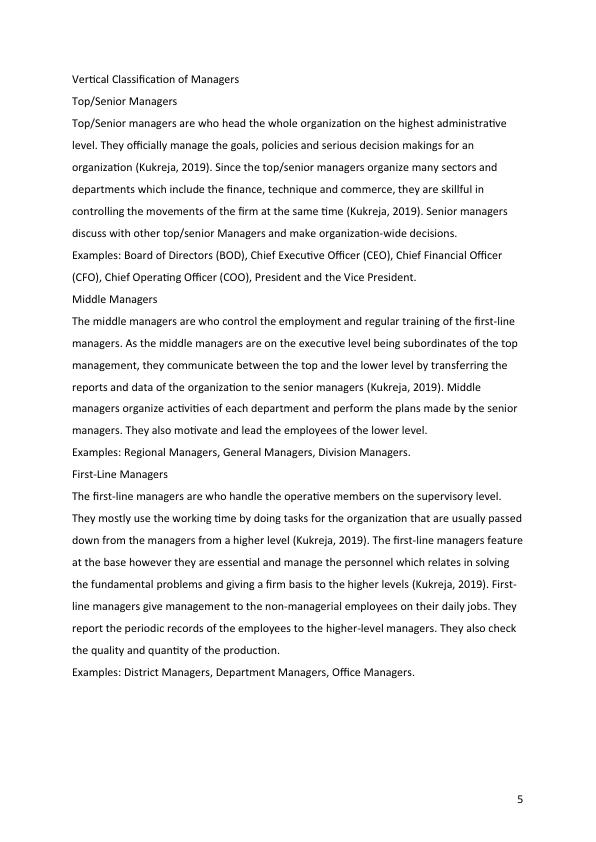
Horizontal Classification of Managers
Line Managers
They are directly in touch either with the products or services to customers. Line manager
supervise the member of staff and the activities of a business and post to the top level
manager (REH, 2020).” They have to take part in controlling and organizing daily and acting
as a liaison between workers and upper level management. The line managers are
Production Manager, Sales Manager, Operations Manager, Logistics Manager and Marketing
Manager (REH, 2020).
Staff Managers
Staff Managers are not directly in contact with the products or the services towards
customers. Staff manager is the person who provides with information and guidance to
the line manager. Staff manager does not interfere in decision making but he helps to take
the decision (Kumar, 2017). Examples: HR Manager, Finance Manager.
6
Line Managers
They are directly in touch either with the products or services to customers. Line manager
supervise the member of staff and the activities of a business and post to the top level
manager (REH, 2020).” They have to take part in controlling and organizing daily and acting
as a liaison between workers and upper level management. The line managers are
Production Manager, Sales Manager, Operations Manager, Logistics Manager and Marketing
Manager (REH, 2020).
Staff Managers
Staff Managers are not directly in contact with the products or the services towards
customers. Staff manager is the person who provides with information and guidance to
the line manager. Staff manager does not interfere in decision making but he helps to take
the decision (Kumar, 2017). Examples: HR Manager, Finance Manager.
6

Management Functions
There are four basic functions of management which are Planning, Organizing, Leading and
Controlling.
Planning
Planning is very important function of management because it involves setting goals and
objectives to meet future intentions (Robbins & Coulter, 2012). The purposes of planning
include establishing goals, making a good decision of the action to achieving objectives,
achieving the high levels of performance and reducing uncertainty. Planning refers to the
manager’s actions which are usually based on plans, logics, decision making, etc. Planning is
done entirely by top managers and flows down to the other organizational levels such as
middle managers and top managers. “Planning is the base upon which all other functions of
the management are built.” (Soundaian, 2011). Planning will prepare the outlook for the future
or prevent the failures.
Organizing
Organizing is the second important function of management which follows planning.
Organizing function helps to develop the organizational structure in preparation for achieving
the goal objectives (Pratap, 2020). A good organizational structure helps the business to grow
faster and improves the outcome results. The organizing is a key of our lives because it will
instruct and organize to achieve goal objectives. If the organizing skill is weak at management,
the organization will meet poor performance and make less effective or efficient.
Leading
Leading in business management helps to achieve organizational goals and provide helpful
guidance (Haque, 2020). To become effective leading, managers must understand how to
adjust the employees’ personalities, emotions, attitudes, and values. A leader needs to provide
important information and give the motivation to energize the employees. As a result, the
employees can work effectively in their specific organization.
Controlling
Controlling is a management function that involves supervising, balancing and using scales to
measure performance over their subordinates in the organization (Robbins & Coulter, 2012).
The controlling function helps to improve the organizational goals to maintain long-term goals
7
There are four basic functions of management which are Planning, Organizing, Leading and
Controlling.
Planning
Planning is very important function of management because it involves setting goals and
objectives to meet future intentions (Robbins & Coulter, 2012). The purposes of planning
include establishing goals, making a good decision of the action to achieving objectives,
achieving the high levels of performance and reducing uncertainty. Planning refers to the
manager’s actions which are usually based on plans, logics, decision making, etc. Planning is
done entirely by top managers and flows down to the other organizational levels such as
middle managers and top managers. “Planning is the base upon which all other functions of
the management are built.” (Soundaian, 2011). Planning will prepare the outlook for the future
or prevent the failures.
Organizing
Organizing is the second important function of management which follows planning.
Organizing function helps to develop the organizational structure in preparation for achieving
the goal objectives (Pratap, 2020). A good organizational structure helps the business to grow
faster and improves the outcome results. The organizing is a key of our lives because it will
instruct and organize to achieve goal objectives. If the organizing skill is weak at management,
the organization will meet poor performance and make less effective or efficient.
Leading
Leading in business management helps to achieve organizational goals and provide helpful
guidance (Haque, 2020). To become effective leading, managers must understand how to
adjust the employees’ personalities, emotions, attitudes, and values. A leader needs to provide
important information and give the motivation to energize the employees. As a result, the
employees can work effectively in their specific organization.
Controlling
Controlling is a management function that involves supervising, balancing and using scales to
measure performance over their subordinates in the organization (Robbins & Coulter, 2012).
The controlling function helps to improve the organizational goals to maintain long-term goals
7

End of preview
Want to access all the pages? Upload your documents or become a member.
Related Documents
Business Plan of Pizza Hut Myanmarlg...
|35
|10278
|636
Business Plan of Shwe Kaung for 2021lg...
|22
|5505
|68
Business and the Business Environment PDFlg...
|37
|8262
|192
Innovation and Commercialization - HNDlg...
|66
|23167
|459
Importance of Effective Leadership on Organizational Successlg...
|47
|10711
|50
Erin Networks (GIP) - Business Plan for 5G Networklg...
|50
|11934
|383
